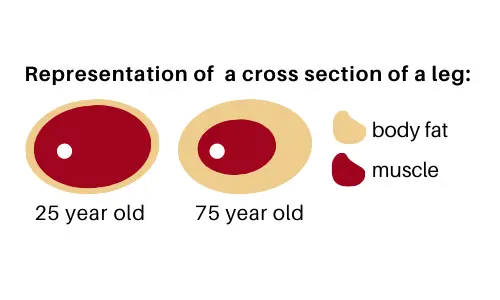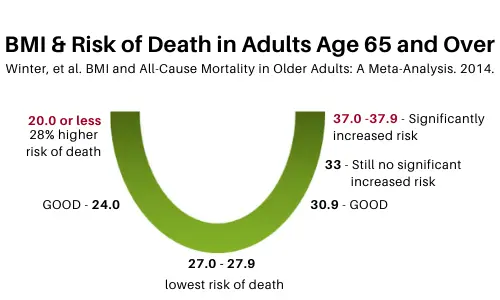Stopping Unintended Weight Loss in Elderly
Let’s talk about unintended weight loss in older adults. It’s a big deal. It robs older adults of their independence. It impacts their quality of life and increases the risk of death and disability. Weight loss in elderly must be stopped.
Why is Unintended Weight Loss in Elderly Such a Big Deal?
When an older adult loses weight unintentionally, they are losing muscle. And think about what we use muscle for- everything! We need muscle to get dressed, walk, bath, cook. We need muscle to have independence. Without muscle we must rely on others to care for us.
 Losing muscle is a big deal because older adults tend to have less muscle to start with. Sarcopenia is the loss of muscle with age. Let’s take a peek at what this looks like.
Losing muscle is a big deal because older adults tend to have less muscle to start with. Sarcopenia is the loss of muscle with age. Let’s take a peek at what this looks like.
This image represents a cross section of a leg. You can Google actual scans of a cross section of the leg- it’s quite interesting! The white dot is meant to represent the bone. The red is muscle. The cream color is body fat.
From the outside both of these legs would look the same size. But since we are looking at the inside, we see that what’s inside looks quite different. The older adult has significantly less muscle.
Now of course there are exceptions. There are older adults in excellent shape and younger adults who are bed bound and very sick. But this graphic illustrates what sarcopenia looks like on the inside.
Different ages, same weight/size, but the older adults have significantly less muscle.
What if They Are Overweight- Isn’t Weight Loss Good?
First off, losing muscle is NEVER a good thing- regardless of weight. Second, Body Mass Index (BMI) reference ranges are DIFFERENT for seniors. BMI is typically used to classify weight status. A BMI of 24.9 – 29.9 is considered overweight and a score greater than 30 and above is obese (1).
 However, good and solid research has shown us that BMI reference ranges are different for older adults. In fact, BMI of 24 – 30 is associated with the lowest rates of death in older adults (2). And yes, you read that right. This range is considered “overweight”. But that’s OK.
However, good and solid research has shown us that BMI reference ranges are different for older adults. In fact, BMI of 24 – 30 is associated with the lowest rates of death in older adults (2). And yes, you read that right. This range is considered “overweight”. But that’s OK.
This graphic is a u-shaped curve that represents BMI and risk of death. Risk increases on both end of the spectrum (too low or too high). The lowest spot on the curve, the sweet spot, is BMI between 27.0 – 27.9. These BMI are associate with the lowest risk of death.
A BMI of up to 30.9 is still good. Even up to 33 there is still no significantly increased risk of death. And we’re in the “obese” range. But again, it’s OK. We don’t see a significantly increased risk until BMI hits 37.0 – 38.0.
However, things get a lot worse when weight decreases. A BMI of 24 is still considered good. But, a BMI or 20.0 or less is associated with a 28% higher risk of death. Yikes. Because of this, we consider a BMI <23 as underweight for older adults. Remember, BMI guidelines are different for older adults.
How Should Weight Be Addressed for Older Adults
We want to be sure we provide the very best care for older adults. So, how should weight be addressed?
- Consult a Registered Dietitian Nutritionist with an expertise in geriatrics.
- Focus on weight stability. No big GAINS. No big LOSSES.
- If weight loss is intended, consult a medical provider and be sure to get enough dietary protein and resistance exercise to protect muscle.
If unintended weight loss starts, make sure that high calories foods are provided to stop the loss and save muscle! You can learn more at Preventing Unintentional Weight Loss in Older Adults and High Calorie Smoothies for Weight Gains.
You can also snag a free copy of my High Calorie Shakes handout at RD2RD Marketplace. I also have a High Calorie Foods SERIES with a high calorie foods list, grocery list, and meal planner. These resources can help stop unintended weight loss in older adults.
And finally, you can purchase the High Calorie SHAKES e-Cookbook for recipes and ideas to STOP unintended weight loss!
How to Stop Unintended Weight Loss in Elderly
As previously mentioned, the best way to stop unintended weight loss in elderly is to provide a high calorie diet. However, it is usually more complicated than just eat more food.
It is important to get to the root issue on why they are losing weight. Maybe they have an underlying issue that is making their body burn more calories (like cancer) or making them have a poor appetite (like depression). This is why working with the health care team is so important.
When providing a high calorie diet, make sure to provide favorite foods that taste good and look appealing. Additionally, you can add high calorie foods in between meals or provide high calorie shakes or smoothies.
Refer to our article Preventing Unintentional Weight Loss in Older Adults for additional ideas.
And if you are looking for even more ideas and support to stop unintended weight loss in elderly, check out our online course: Gaining Weight Made Easy.
This course is designed to help you (or someone you love) gain weight with simple strategies and easy to use tools. I know there is a lot of information out there. I know it can be confusing. Gaining weight doesn’t have to be hard. I’m here to help make it easy for you.
What you get:
- 12 Video Educational Course $197 ($394.00 value)
- High Calorie RECIPES e-Cookbook FREE ($19.99 value)
- High Calorie SHAKES e-Cookbook FREE ($19.99 value)
- Weight Gaining SECRETS e-Book FREE ($19.99 value)
- High Calorie Foods List FREE ($4.99 value)
- The High Calorie Meal Planner FREE ($4.99 value)
- High Calorie Grocery List FREE ($4.99 value)
- Sample Weight Gaining Meal Plan FREE ($9.99 value)
- Weight Tracking Log FREE ($4.99 value)
To learn more or purchase this course, click here.
The Bottom Line on Weight Loss in Elderly
Here’s the bottom line. Unintended weight loss leads to muscle loss. Muscle loss leads to loss of independence, increased fall risk, and risk of early death. Weight loss in elderly is a big deal. It’s up to us to stop unintended weight loss in older adults.

By now, you KNOW it’s a big deal. But how do you convince other people? Good meaning colleagues, patients, or their families don’t always understand why this is such a big deal. They may see weight loss in elderly as a “good” thing or have no concern when it is occurring.
 I have a solution for you! I have created a one-page handout that makes it EASY to understand WHY unintended weight loss is detrimental in older adults. This handout contains the exact information you learned in this article.
I have a solution for you! I have created a one-page handout that makes it EASY to understand WHY unintended weight loss is detrimental in older adults. This handout contains the exact information you learned in this article.
Snag your free copy of the Unintended Weight Loss handout. Share it with patients and colleagues… you can even post it on a bulletin board! This handout will become your first line of defense in protecting the health and well-being of the older adults you care for.
Weight loss in elderly must be stopped.
Good meaning people WANT to help. Let’s spread the word and CHANGE how we approach weight loss in elderly.
References
- All About BMI. Centers for Disease Control and Prevention Website. https://www.cdc.gov/healthyweight/assessing/bmi/adult_bmi/index.html. Updated August 29, 2017. Accessed February 2, 2020.
- Jane E Winter, Robert J MacInnis, Naiyana Wattanapenpaiboon, Caryl A Nowson. BMI and all-cause mortality in older adults: a meta-analysis. The American Journal of Clinical Nutrition. Volume 99, Issue 4, April 2014, Pages 875–890. https://doi.org/10.3945/ajcn.113.068122.
